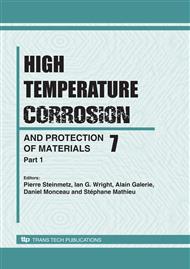p.473
p.483
p.491
p.501
p.511
p.519
p.529
p.539
p.549
A Review of Haynes® 230® and 617 Alloys for High Temperature Gas Cooled Reactors
Abstract:
HAYNES® 230® and 617 alloys are competing for use on Generation IV, high temperature gas cooled reactor components because of good high temperature creep strength in the temperature range between 760°C and 982°C and resistance to oxidation in the gas cooled reactor environment. A review of the metallurgy affecting the properties in each alloy will be discussed. Grain size and carbide precipitation developed during fabrication effect short term and long term ductility, fatigue, and creep. For example, 230 alloy has a finer grained structure which promotes fatigue strength with a slight sacrifice in creep strength. The 617 alloy has a coarser grain structure which provides slightly higher creep resistance while sacrificing some fatigue strength. Thermal aging also introduces gamma prime precipitation to the 617 alloy as well as grain boundary carbides, and this, in addition to grain boundary oxidation, reduces the low cycle fatigue strength of 617 alloy compared to 230 alloy. Independent studies have shown that 230 alloy possesses higher resistance to thermal fatigue than 617 alloy. However, welds of both base metals with similar weld composition have about the same thermal fatigue life. Cooling rates from solution annealing temperatures during processing effect the ductility and creep strength of these alloys with the highest cooling rates preferred for retention of ductility and creep strength. The reason; slow cooling rates promote carbide precipitation in the grain boundaries which reduces ductility and creep strength.
Info:
Periodical:
Pages:
511-517
Citation:
Online since:
September 2008
Authors:
Price:
Сopyright:
© 2008 Trans Tech Publications Ltd. All Rights Reserved
Share:
Citation:


